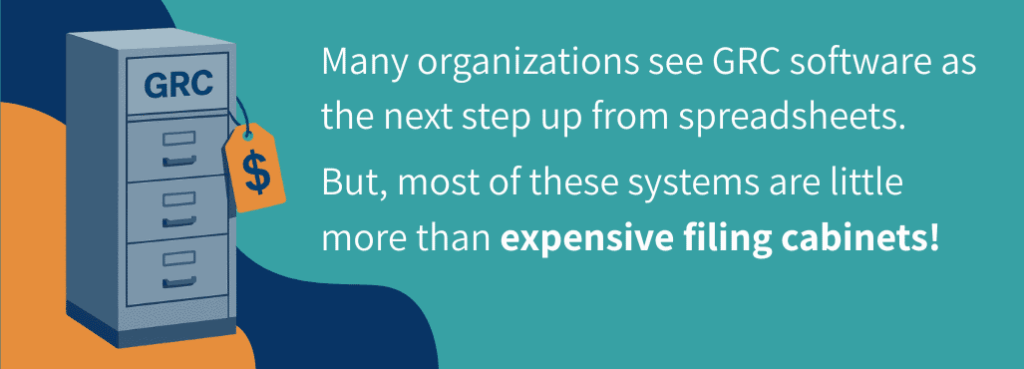The Hidden Cost of Spreadsheets — Why ERM Beats GRC at Managing Complexity
Last Updated: July 3, 2025
Introduction: The Spreadsheet Trap
Spreadsheets have become a crutch in modern organizations. They’re deceptively simple, universally accessible, and incredibly familiar. But beneath that comfort lies a significant risk. The hidden cost of spreadsheets isn’t just a few extra manual hours — it’s the systemic drag they introduce into risk management programs. It’s the missed dependencies, the slow reaction times, the fragmented data, and the ripple effects of decisions that remain unseen until they hit like a freight train.
In fact, many organizations believe they’ve “graduated” from spreadsheets when they purchase Governance, Risk, and Compliance (GRC) software, only to find that most GRC solutions are merely glorified spreadsheets in a more sophisticated wrapper. They reinforce silos and serve as filing cabinets rather than systems of action. They offer tracking, not transformation.
To truly combat operational drag, organizations need a system that does more than store information. They need Enterprise Risk Management (ERM) platforms that are dynamic, interconnected, and capable of surfacing risks in real-time, like LogicManager.
The Silent Killers of Risk Programs: Spreadsheets and Manual Processes
Spreadsheets introduce risks that are so pervasive, they often go unnoticed until they compound into significant failures. Here’s how they silently erode your risk management efforts:
Missed Dependencies
Spreadsheets are static. They don’t automatically update related records when you make changes. For example, if you update a control in one spreadsheet but forget to update the same control in another process’s register, you’ve just introduced a risk gap. Manual oversight is inevitable in complex systems where interconnected processes are not visibly linked.
Slow Reaction Times
When risks emerge — think of a supplier failing a security audit or a new regulation being published — spreadsheets require a manual ripple effect. Someone has to remember to check all the places that risk touches. By the time someone realizes the impact, the window for proactive mitigation has usually closed.
Hidden Operational Costs
The hours spent chasing down version histories, sending email reminders, and reconciling data from different sources don’t typically show up on a balance sheet. But they manifest as reduced bandwidth, employee frustration, and ultimately, slower execution of strategic initiatives. The hidden labor cost in spreadsheet-driven risk management is enormous.
Fragmented Accountability
Spreadsheets are typically owned by individuals or isolated teams. When risks cross departmental lines — as they almost always do — it’s difficult to track ownership and accountability. Spreadsheets enable “not my spreadsheet” behavior.
Compounded Errors
Copy-paste mistakes, version mismatches, and formula errors have caused public-facing disasters in the past. JP Morgan’s $6 billion trading loss, partly attributed to spreadsheet errors, is a cautionary tale for risk managers everywhere.

Why GRC Software Doesn’t Solve the Problem
Many organizations see GRC software as the next step up from spreadsheets. Unfortunately, most GRC systems are little more than expensive filing cabinets that codify existing silos rather than eliminating them.
GRC = Glorified Spreadsheets
Most GRC platforms focus on recording risks, controls, policies, and incidents. They offer a place to store this information but do not dynamically link these items in a way that reveals the true interconnectedness of an organization’s ecosystem.
Point Solutions Disguised as Integrated Tools
A GRC system might offer a policy management module, an incident management module, and a risk assessment module — but they rarely talk to each other effectively. You’re managing processes in parallel, not in sync.
Inadequate Change Propagation
When a risk changes — for example, a supplier’s security posture degrades — GRC systems don’t automatically update the related controls, processes, and vendor risk profiles. The burden of cross-checking still falls to humans.
Reinforcing Manual Bottlenecks
Most GRC systems require users to manually update related items and push tasks through workflow engines that feel more like paper shuffling than genuine process automation.
ERM: The Cure for Operational Drag
Enterprise Risk Management (ERM) platforms like LogicManager are fundamentally different. They are built to manage complexity, not just document it.
A Connected Risk Ecosystem
An ERM platform interconnects risks, controls, vendors, policies, incidents, and more — using relationship-based intelligence. If a change is made to one item, the system automatically cascades those updates across related records.
Example: If a critical IT control is flagged as failed in a LogicManager assessment, the system can immediately notify all owners of related processes, impacted vendors, and dependent controls. Action plans can be launched instantly, not weeks later.
Real-Time Risk Ripples
LogicManager’s Risk Ripple Intelligence ensures that when a risk changes, the effects are surfaced instantly across all connected areas. This allows organizations to act on information before it snowballs into a crisis.
Example: If a new regulatory requirement is introduced, the ERM system maps which processes, controls, and vendors are affected and generates targeted action steps — without waiting for someone to manually connect the dots.
More Value Than You Input
With a spreadsheet, the value is linear: you get out what you put in. With LogicManager, you get more out than you put in. Every data point enhances the network of relationships and improves predictive insights across the system.
Process Automation that Works
ERM platforms can trigger tasks, assign responsibilities, track completion, and escalate automatically. This eliminates the need for manual follow-ups and email chases.
Holistic Governance
ERM isn’t a point solution. It’s a governance engine that ties together risk management, compliance, audit, policy, third-party, and operational workflows into one unified system.
How Spreadsheets and GRC Fail to Surface Risk Ripples: Real-World Examples
Example 1: Third-Party Vendor Security Breach
Spreadsheet Scenario:
A cybersecurity team tracks vendor assessments in a spreadsheet. When a vendor fails a critical security audit, the team updates the vendor’s risk profile, but other teams — like Procurement and Operations — remain unaware. A month later, that same vendor’s software is implicated in a data breach because a dependent process still relied on it.
ERM Scenario:
In LogicManager, the vendor’s failed assessment would automatically update all linked processes and controls. Affected departments would be notified immediately, and corrective action plans could be launched within hours.
Example 2: Regulatory Change Impacting Financial Reporting
Spreadsheet Scenario:
The Compliance team learns of a new financial regulation. They update their policies, but forget to notify the Internal Audit team. By the time the next audit cycle comes around, critical gaps have emerged, exposing the company to compliance risk.
ERM Scenario:
With LogicManager, the regulation change would automatically trigger reviews of impacted controls, notify Internal Audit, and update the relevant risk registers.
Example 3: Product Recall in Manufacturing
Spreadsheet Scenario:
A product defect is discovered, but the team managing supplier quality control doesn’t realize the defect also affects components used in a secondary product line. The issue is only surfaced after a customer complaint escalates.
ERM Scenario:
LogicManager’s interconnected framework would instantly flag all other products using the same supplier’s materials, prompting a proactive inspection and potentially avoiding the second recall entirely.

5 Ways to Know You’re Outgrowing Spreadsheets
Here’s a quick checklist to evaluate whether you’ve reached the breaking point:
- You’re constantly emailing for status updates.
If manual follow-ups are your main workflow driver, you’ve outgrown spreadsheets. - You maintain duplicate records across multiple spreadsheets.
If you’re copying and pasting data between files, you’re not managing risk — you’re managing chaos. - You’ve lost track of ownership.
When no one knows who owns a risk, control, or process — or when ownership shifts aren’t recorded in real-time — your spreadsheets are failing you. - Your risk assessments don’t trigger automatic next steps.
If identifying a risk is a dead end instead of a workflow starter, you need to level up. - You’ve had a near-miss or failure because someone didn’t know something changed.
This is the clearest sign that your system isn’t designed to surface ripple effects.
How to Map Your Spreadsheet-Based Processes into an ERM Platform
Moving from spreadsheets to an ERM system can feel overwhelming, but it doesn’t have to be. Here’s a structured approach to get you started:
Step 1: Inventory Your Spreadsheets
List all the spreadsheets you use to track risks, controls, incidents, policies, vendors, and audits. Identify where duplication exists and which processes these spreadsheets support.
Step 2: Identify Relationships
For each spreadsheet, ask:
- What processes rely on this information?
- Which teams use this data?
- What other data points should be connected?
This will help you map dependencies that need to be captured in your ERM platform.
Step 3: Define Workflows
Determine what should happen when:
- A new risk is identified
- A control fails
- A vendor is reassessed
- A regulation changes
Outline workflows that currently rely on emails, status meetings, and manual follow-ups.
Step 4: Structure Your ERM Framework
Using an ERM system like LogicManager:
- Build out libraries of risks, controls, vendors, policies, and processes.
- Use the system’s relationship mapping tools to link these elements.
- Set up workflows and automated notifications.
Step 5: Migrate Your Data
Start by importing static lists: risks, controls, vendors. Then gradually layer on the workflows and relationships. This phased approach minimizes disruption.
Step 6: Train Teams
Ensure that everyone understands the new system. Focus on how it reduces manual work and increases visibility. LogicManager’s guided onboarding and in-platform AI assistant, LogicManager Expert, can help.
Step 7: Monitor and Optimize
Track adoption, measure response times to emerging risks, and continuously refine your processes. The goal is to move from reactionary risk management to proactive governance.
Conclusion: Break Free from Operational Drag
Spreadsheets might have served you well in the past, but they’re not built for the complexity and speed of modern risk environments. Even GRC solutions that seem like a step up often trap you in the same cycle of fragmented processes and delayed reactions.
Enterprise Risk Management platforms like LogicManager don’t just store information — they connect it. They empower your teams to see the full picture, to act on risk ripples in real-time, and to truly manage complexity instead of being buried by it.
If you’re ready to move beyond spreadsheets and start leveraging a system of action instead of a system of record, it’s time to explore ERM.
